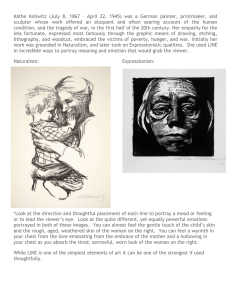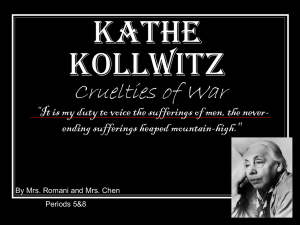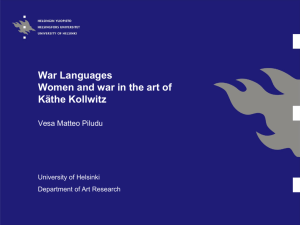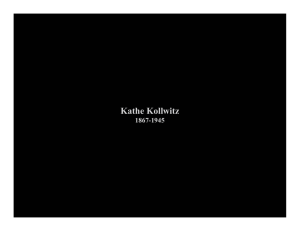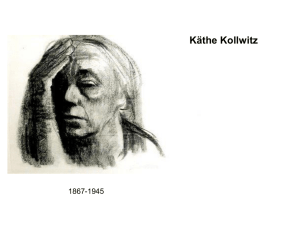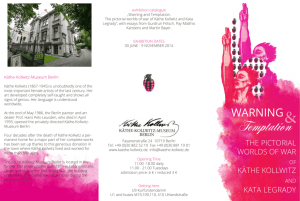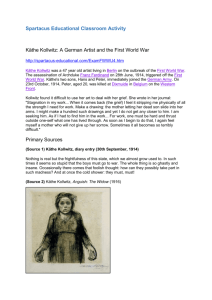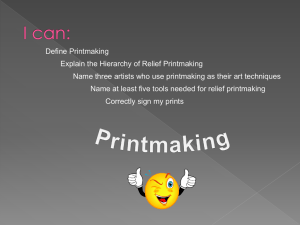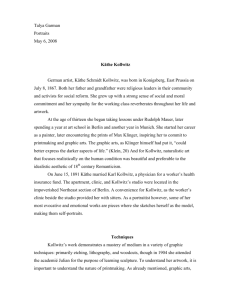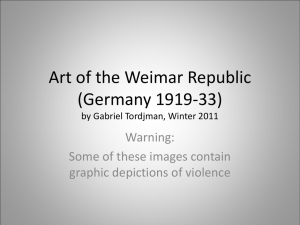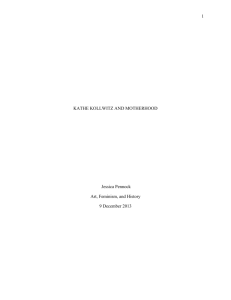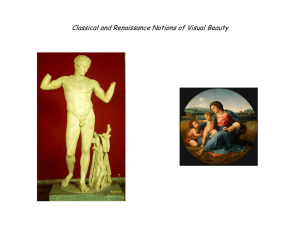Ralph Shikes, on Kathe Kollwitz from The Indignant Eye, pp. 255-268.
advertisement
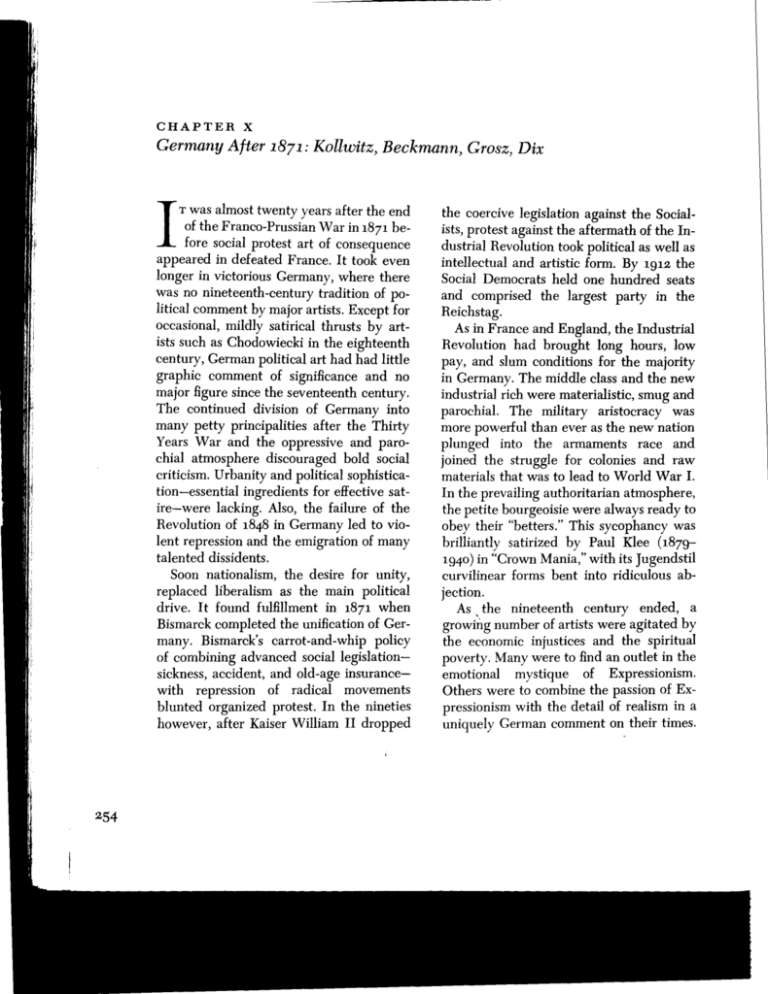
CHAPTER X Germany After _z 871 : Kollwitz, Beckmann, Grosz, Dix T was almost twenty years after the end of the Franco-Prussian War in i87i before social protest art of consequence appeared in defeated France . It took even longer in victorious Germany, where there was no nineteenth-century tradition of political comment by major artists. Except for occasional, mildly satirical thrusts by artists such as Chodowiecki in the eighteenth century, German political art had had little graphic comment of significance and no major figure since the seventeenth century. The continued division of Germany into many petty principalities after the Thirty Years War and the oppressive and parochial atmosphere discouraged bold social criticism. Urbanity and political sophistication-essential ingredients for effective satire-were lacking. Also, the failure of the Revolution of 1848 in Germany led to violent repression and the emigration of many talented dissidents . Soon nationalism, the desire for unity, replaced liberalism as the main political drive. It found fulfillment in 1871 when Bismarck completed the unification of Germany . Bismarck's carrot-and-whip policy of combining advanced social legislationsickness, accident, and old-age insurancewith repression of radical movements blunted organized protest . In the nineties however, after Kaiser William 11 dropped the coercive legislation against the Socialists, protest against the aftermath of the Industrial Revolution took political as well as intellectual and artistic form . By 1912 the Social Democrats held one hundred seats and comprised the largest party in the Reichstag. As in France and England, the Industrial Revolution had brought long hours, low pay, and slum conditions for the majority in Germany. The middle class and the new industrial rich were materialistic, smug and parochial. The military aristocracy was more powerful than ever as the new nation plunged into the armaments race and joined the struggle for colonies and raw materials that was to lead to World War I. In the prevailing authoritarian atmosphere, the petite bourgeoisie were always ready to obey their "betters ." This sycophancy was brilliantly satirized by Paul Klee (18791940) in "Crown Mania," with its Jugendstil curvilinear forms bent into ridiculous abjection . As_ the nineteenth century ended, a growing number of artists were agitated by the economic injustices and the spiritual poverty . Many were to find an outlet in the emotional mystique of Expressionism . Others were to combine the passion of Expressionism with the detail of realism in a uniquely German comment on their times. Germany After z87z 254 Kdthe Kollwitz (1867-1945) veered from naturalism to Expressionism during her long career . Aside from the intrinsic interest of her work, her career spanned vital years and is worth exploring in some detail . Boundless compassion and lifelong commitment to her fellow man were the qualities that made her so rare a person and so uniquely compelling an artist . Her life was marked by a deeply felt empathy for the struggling men and women whose burdens 254. "Crown Mania." Paul Klee . 1904 . 61/x61/4. pressed on her daily in the working-class district of Berlin where she lived. Kdthe's father was a socialist, her grandfather an independent minister who had been expelled from the official state church . Socialism, religion, and her sense of commitment were the motifs of her moral and social growth. "Man is not here to be happy, but to do his duty" reads the inscription on her grandfather's gravestone . Her father early recognized her talent for drawing and encouraged her to train for a career as an artist . Her first teacher was an engraver. She studied art in Munich and Berlin, but to her father's disappointment-he doubted that she could pursue two careers at once-she married, at twenty-three, a young doctor, Karl Kollwitz . Her husband headed a tailors' medicare clinic in a Berlin working-class district, where they lived for fifty years. In the mid-nineties "a milestone in my work" took place, she wrote. She attended a performance of Gerhart Hauptmann's The Weavers, a drama about an abortive strike of 1840 . Its overtones for the Germany of her time inspired her to begin work immediately on her own version. The six-part cycle of prints was submitted to the Great Exhibition at the Lehrter Bahnhof in Berlin in 1898 . The jury voted her the gold medal, but the Kaiser, who hated what he called "gutter art," set aside the award. Overnight she had won an audience, and years later copies of "The Weavers" sequence were still found in workers' homes throughout Germany. Etching and aquatint . Museum of Modern Art, New York. 255 256 255. "Conspiracy." Kathe Kollwitz. 1895 . National Gallery of Art, Washington . 111/>x7 . Etching. Plate No . 3 from The Weavers. Rosenwald Collection . Germany After z877 Two of these prints will suffice to show why the Kaiser was made uneasy . "Conspiracy" captures a scene repeated all over Europe : a huddle of desperate men plotting to fight against their miserable living conditions . The dim light, the tense faces, the hunched postures, all combine to make the sympathetic viewer hope that no gov- ernment police are near. The inexorable loom in "The End" dominates the cottage where the dead are brought after the revolt fails. The mother-one of the first of Kollwitz's unforgettable mothers-looks on . In "The Weavers," Kollwitz employed a pictorial naturalism . The prints have the weakness of story illustration ; only later 256. "The End." Kathe Kollwitz . 1897 . gi/x1 2. Etching and aquatint . Plate No . 6 from The Weavers. Library of Congress, Washington . a x F 0 z bAD r W C7 N k .i M O .a N 3 0 W W F c z z a) cd A z M h W 1-i biD x F CC A n N U 0 N Germany After z871 was she to develop a much greater economy of means as she evolved toward a less detailed Expressionism . Despite her liberal-radical upbringing, Kathe Kollwitz was dominated at this time more by artistic than political considerations in the selection of subject . In her diary, she notes: I should like to say something about my reputation for being a "socialist" artist, which clung to me from then on. Unquestionably my work at this time, as a result of the attitudes of my father and brother and of the whole literature of the period, was in the direction of socialism . But my real motive for choosing my subjects almost exclusively from the life of the workers was that only such subjects gave me in a simple and unqualified way what I felt to be beautiful . For me the Koenigsberg longshoremen had beauty ; the Polish jimkes on their grain ships had beauty ; the broad freedom of movement in the gestures of the common people had beauty . Middle-class people held no appeal for me at all . Bourgeois life as a whole seemed to be pedantic . The proletariat, on the other hand, had a grandness of manner, a breadth to their lives . Much later on, when I became acquainted with the difficulties and tragedies underlying proletarian life, when I met the women who came to my husband for help and so, incidentally, came to me, I was gripped by the full force of the proletarian's fate. Unsolved problems such as prostitution and unemployment grieved and tormented me, and contributed to my feeling that I must keep on with my studies of the lower classes. And portraying them again and again opened a safety valve for me; it made life bearable. The theme of revolt against oppression was employed even more dramatically in a series of seven plates she executed from 19oi-o8, based on the sixteenth-century Peasants' War . "Outbreak" is an impassioned call to arms. Even the peasants in "The Prisoners," the final etching in the series, give one the feeling that their hatred is implacable, that whatever their fate, the struggle will continue. There is strength, movement, and passion in these etchings, revealing the sure hand of a decisive artist, if a still primarily representational one . War was a constant motif in Kathe Kollwitz's art and life. Within a few years after completing the Peasants' War cycle, she and most of Germany's artists were swept into the vortex of World War I . Perhaps never before had a single event had so shattering an effect on so many artists . One of the most interesting groups of artists to emerge in the early twentieth century was Die Brucke or The Bridge, founded in 1905 by Karl Schmidt-Rottluff, Erich Heckel, and Ernst Ludwig Kirchner (later joined by Emil Nolde, Otto Mueller, and Max Pechstein). Alienated by German society, they assailed bourgeois values by the shock of their Expressionism, but their rebellion was more artistic than social or political . All six served in the army, Kirchner suffering a breakdown . Many other German artists, interrupted in their peacetime search for new modes of THE INDIGNANT EYE 258 26o "The Prisoners." Kathe Kollwitz . 19o8 . Galerie St . Etienne, New York . 258 . 127/Hxi 6 H. Etching. Plate No . 7 from "The Peasant's War." The Germany After z87z expression in painting, were killed or wounded or underwent severely traumatic experiences in the war. Franz Marc and August Macke of Der Blaue Reiter (The Blue Rider) group were killed ; Oskar Kokoschka and Otto Dix were wounded; Ludwig Meidner, Max Beckmann, and George Grosz served in the German army and survived, but with psychological scars that deeply affected their outlook and their work. The mood of agitation and despair that characterized much of Germany's postwar art certainly was a direct by-product of the war. Kathe Kollwitz's eighteen-year-old son Peter volunteered for what he believed to be the defense of Germany. She was torn between respect for his sense of duty and revulsion against the act of war. "In such times it seems so stupid that the boys must go to war," she wrote in her diary. "The whole thing is so ghastly and insane . Occasionally there comes the foolish thought : how could they possibly take part in such madness? And at once the cold shower : they must, must!" A month later Peter was killed . Her bitterness and hatred of war mounted. As her son Hans noted, "To her dying day, she held to the belief, `No more war."' Her lithographs, woodcuts, and posters in the postwar years caught in a few strokes the universal grief of the shattered women and children left behind . The flaming poster, "Never Again War!" powerfully expresses her militant pacifism . In contrast to her early work, there is no detail here, no back- ground, no pictorial treatment-only emotion expressed with swift, broad, sure strokes. For several years she worked on a "War" cycle, which finally emerged in i925 as a series of seven woodcuts, almost wholly Expressionist . "The Parents," reproduced here, is massive, overwhelming and eternal . Now master of several media, she turned to woodcuts as the best way to express grief. "Sorrow is all darkness," she wrote when reworking the "Parents" block, noting that her first attempts were "much too bright and harsh and distinct ." Disillusionment, widespread hunger, despair, violence, and chaos gripped Germany. Workers' and sailors' revolts brought an end to imperial rule . Moderate Social Democrats gained power and the inevitable clash occurred with the left-wing Socialists who advocated a social and economic as well as a political revolution . A revolt in Berlin in igig by left-wing Socialists known as Spartacists was crushed by the government and the army, and its leaders, Karl Liebknecht and Rosa Luxemburg, were brutally slain . Kathe Kollwitz's Expressionist woodcut, "Memorial to Karl Liebknecht," is a moving visualization of grief, bitterness, and betrayal . She noted in her diary that she felt she had "the right to portray the working class's farewell to Liebknecht, and even to dedicate it to the workers, without following Liebknecht politically." And, typically, she added, "Or isn't that so?" Much of the agony of the Weimar Be- 259 262 York . 259. "Never Again War!" Kathe Kollwitz . 1924 . 361/2x2'71/1. Lithograph. The Galerie St . Etienne, New r'ernwny After 1871 0 26o. "The Parents ." Kathe Kollwitz . 1923 . 13 1/2x16 1/4. Woodcut. New York Public Library . 263 26 1 public is reflected in the work of Kollwitz and other German artists . The social Democrats pinned their hopes on President Wilson's Fourteen Points, only to see them betrayed . Combating the militant leftSocialists and Communists, they made an alliance with the monarchist, right-wing, 264 261 . "Memorial to Karl Liebknecht." Kathe Kollwitz . York . antirepublican military establishment that was to prove fatal to German democracy . The "war guilt" label pinned to the German and the French occupation of the Ruhr spurred the propaganda mills of the right-wing nationalists . The fall of the mark-from seventy-five to the dollar in 1919-20 . 13%xlg: %4 . Woodcut. The Galerie St. Etienne, New Germany After 1871 ig2i, to a million to the dollar, and then to worthlessness in 1923-wiped out the savings of the middle and lower classes and benefited the industrialists and large landlords. It was a period of hopeless misery for the poor . The bleak lives of the workers who were her neighbors and her husband's patients continued to elicit Kdthe Kollwitz's compassion . She listened sympathetically to the wives' stories of poverty and struggle, absorbed their experiences, and transmuted them into art. In "Lunch Hour" she sketched the workers' emptiness and hopelessness . Her magnificent posters for hungerwracked Germany-"Germany's Children Are Starving!" and "Bread!"-were powerful, direct statements. Many other German artists also protested the brutality of the times, especially George Grosz and Otto Dix, the Verists. But in place of their harsh, strident angry attacks, Kollwitz manifested anguish. Instead of lashing out, as they did, at society's exploiters, she expressed her feelings through its victims . Where they displayed contempt for humanity, she projected love and empathy. Deep as her sympathies were, she found herself repelled by violence . "I have been through a revolution," she wrote in her diary, "and I am convinced that I am no revolutionist. My childhood dream of dying on the barricades will hardly be fulfilled, because I should hardly mount a barricade now that I know what they are like in reality." Her identification with the struggle for existence, however, never faltered . She wrote : "Everyone works the way she can . I am content that my art shall have purpose outside itself . I would like to exert influence in these times when human beings are so perplexed and in need of help." It is difficult to estimate whether her work did actually "exert influence," but there is no question that her haunting, emaciated faces stirred consciences, and her humanistic woodcuts and lithographs moved thousands for a generation . Her later years were filled with anxiety, pain, and repression . Hitler's seizure of power led inevitably to the banning of her works, and although she was offered a home in America, she remained in Germany until the end. Her beloved husband died, and her oldest grandson was killed in action . Characteristically, her last work, a defiant plea for peace, "Seed for the Planting Must Not Be Ground," shows a mother protecting her three children from the threat of war. As Romain Rolland wrote of her, The work of Kdthe Kollwitz which reflects the ordeal and the pain of the humble and simple is the grandest German poem of the age . This woman of virile heart has looked on them, has taken them in her motherly arms, with a solemn and tender compassion. She is the voice of the silence of the sacrificed. At various times until 1933 Kdthe Kollwitz contributed drawings to Germany's THE INDIGNANT EYE 262 266 262. "Lunch Hour ." Kathe Kollwitz . agog . i8l,~2xU. Pen and wash drawing. The Galerie St. Etienne, New York . Germany After z87z 263 263 . "Bread!" Kathe Kollwitz . 1924 . 31',x12 . Drawing. The Galerie St. Etienne, New York . THE INDIGNANT EYE 264 lively satirical weekly, Simplicissimus . This rather elegant magazine of political and social protest was cofounded in 1-896 by Th. Th. (for Thomas Theodore) Heine (18671-948), whose graphic satires needled two 268 generations of Germans until he fled the Nazis in 1-933 . Simplicissimus was essentially middleclass liberal in contrast to the working-class appeal of L'Assiette au Beurre in France . 264. "Seed for the Planting Must Not Be Ground ." Kathe Kollwitz . 1942 . 14%x15'h . Lithograph . The Galerie St. Etienne, New York .
